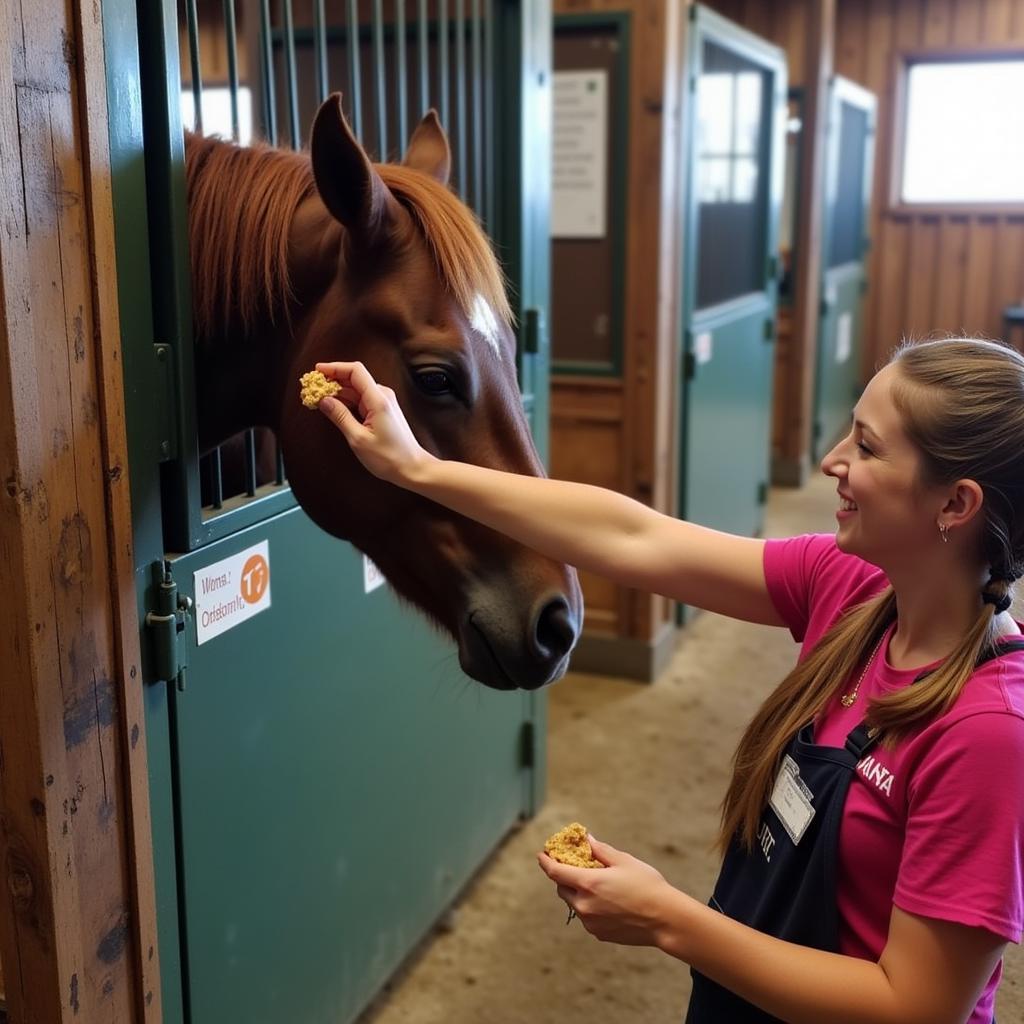A Chute Horse, often misunderstood, plays a vital role in various equine activities. From veterinary procedures to rodeo events, understanding their purpose and proper handling is crucial. This article dives into the world of chute horses, exploring their different uses, training techniques, and the importance of prioritizing their well-being.  Chute Horse in Veterinary Setting
Chute Horse in Veterinary Setting
What is a Chute Horse?
A chute horse is trained to stand calmly and patiently within a specialized enclosure known as a chute. This controlled environment allows for easier handling and management of the horse during various activities. While the term “chute horse” might conjure images of rodeo, their use extends far beyond the arena. They’re invaluable in veterinary practices, breeding operations, and even for routine hoof care.
Chute Horses in Veterinary Medicine
Veterinarians rely on chutes to safely perform procedures like vaccinations, dental work, and even minor surgeries. A well-trained chute horse minimizes stress for both the horse and the vet, enabling efficient and safe treatment. horse breeding chute
Chute Horses in Breeding
Breeding chutes, specifically designed for controlled breeding, play a significant role in equine reproduction. They provide a safe environment for both the mare and stallion, minimizing the risk of injury during the breeding process. These specialized chutes often feature padded sides and secure restraints, ensuring the well-being of both animals. breeding chute for horses
Chute Horses in Rodeo
In the rodeo world, chute horses are synonymous with bucking events. These horses are carefully selected and trained to perform specific bucking patterns, adding to the excitement and challenge of the competition. The care and well-being of these animals are paramount, with strict regulations in place to ensure their humane treatment.
Training a Chute Horse: Patience and Positive Reinforcement
Training a horse for chute work requires patience, understanding, and a commitment to positive reinforcement. Desensitization plays a crucial role, gradually introducing the horse to the chute and its various components. Building trust is essential, rewarding calm behavior and minimizing any negative experiences.  Training a Chute Horse with Positive Reinforcement
Training a Chute Horse with Positive Reinforcement
Building Trust and Confidence
The key to successful chute training lies in establishing a strong bond between horse and handler. Positive reinforcement, using rewards like treats and praise, helps create a positive association with the chute. Starting slowly, allowing the horse to explore the chute at its own pace, is vital for building confidence.
Desensitization and Gradual Introduction
Introducing the horse to the chute gradually is crucial. Start by simply leading the horse around the chute, allowing it to sniff and investigate. Next, encourage the horse to step into the chute for short periods, rewarding calm behavior. Over time, gradually increase the duration the horse spends in the chute, always prioritizing the horse’s comfort and confidence.
“Building a positive association with the chute is paramount,” says renowned equine behaviorist, Dr. Amelia Carter. “Patience and positive reinforcement are the cornerstones of effective chute training.”
Maintaining a Calm Environment
Maintaining a calm and quiet environment during training is essential. Loud noises or sudden movements can spook the horse and hinder the training process. Consistency is key, ensuring that each training session is positive and reinforces the desired behavior. horse trapper
Ensuring the Well-being of Chute Horses
The welfare of chute horses is of utmost importance. Regular veterinary check-ups, proper nutrition, and adequate rest are essential for maintaining their physical and mental health. Recognizing signs of stress or discomfort and adjusting training accordingly is crucial for responsible horse ownership.  Veterinary Checkup for Chute Horse
Veterinary Checkup for Chute Horse
“Prioritizing the horse’s well-being is non-negotiable,” emphasizes Dr. Carter. “Regular monitoring and adjustments to training are crucial for ensuring the horse’s physical and mental health.”
Conclusion
The chute horse, whether in a veterinary clinic or a rodeo arena, plays a diverse role in the equine world. Understanding their purpose, training methods, and the importance of their well-being is vital for responsible horse ownership and management. By prioritizing their care and employing ethical training techniques, we can ensure that chute horses continue to contribute to various equine activities safely and effectively. Remember, a well-trained and cared-for chute horse is a valuable partner. bucking horse breeders
FAQ
-
What is the primary purpose of a chute? To provide a controlled environment for various equine activities, from veterinary care to breeding and rodeo.
-
What training method is most effective for chute horses? Positive reinforcement, combined with desensitization and gradual introduction.
-
How can I ensure the well-being of my chute horse? Regular veterinary checkups, proper nutrition, adequate rest, and monitoring for signs of stress.
-
Are chute horses used only in rodeo? No, they are also used in veterinary practices, breeding operations, and for routine hoof care.
-
What is the key to successful chute training? Building trust and confidence through positive reinforcement and patience.
-
Why are breeding chutes important? They provide a safe and controlled environment for breeding, minimizing the risk of injury.
-
What are some signs of stress in a chute horse? Pawing, sweating, head tossing, and vocalizations. horse bunk beds
Some other questions you might have include the specific breeds best suited for chute work, the design differences between various types of chutes, and the legal regulations surrounding their use in rodeo. You can find more information on these topics and more on our website. For immediate assistance, please contact us at Phone Number: 0772127271, Email: [email protected], or visit us at QGM2+WX2, Vị Trung, Vị Thuỷ, Hậu Giang, Việt Nam. Our customer service team is available 24/7.